Charles E W Bean, Diaries, AWM38 3DRL 606/260/1 - 1916 - 1930 - Part 10
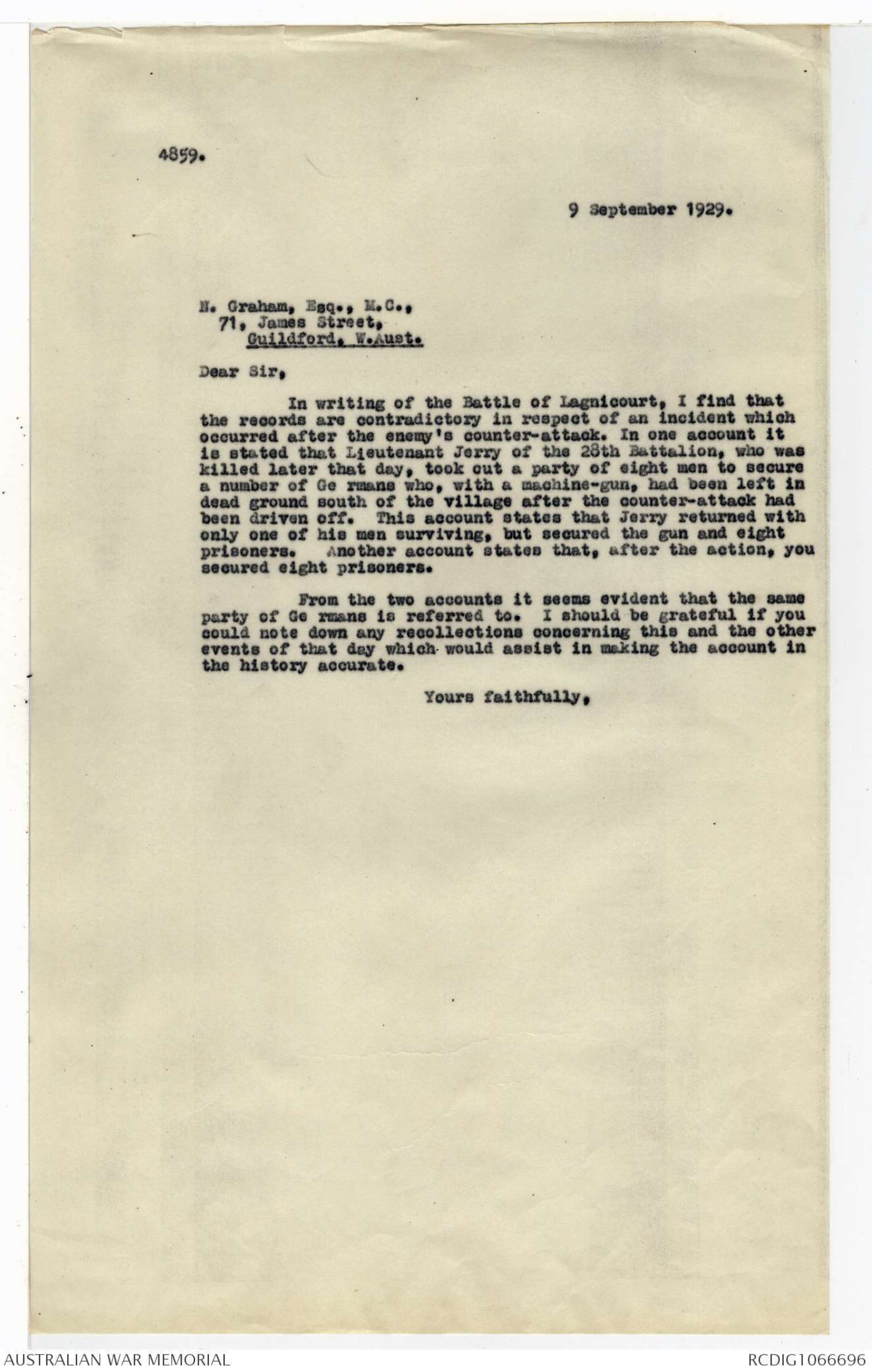
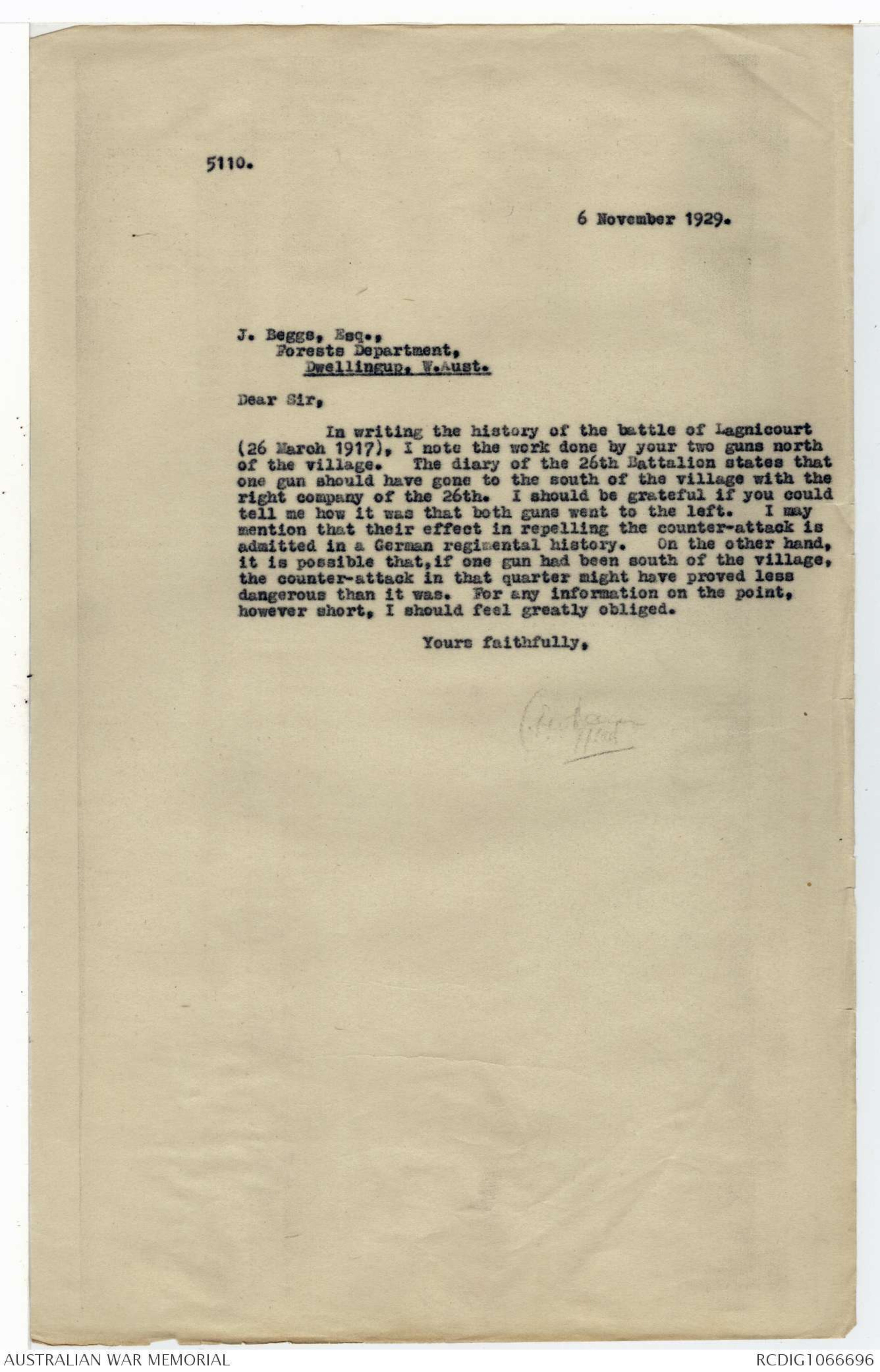
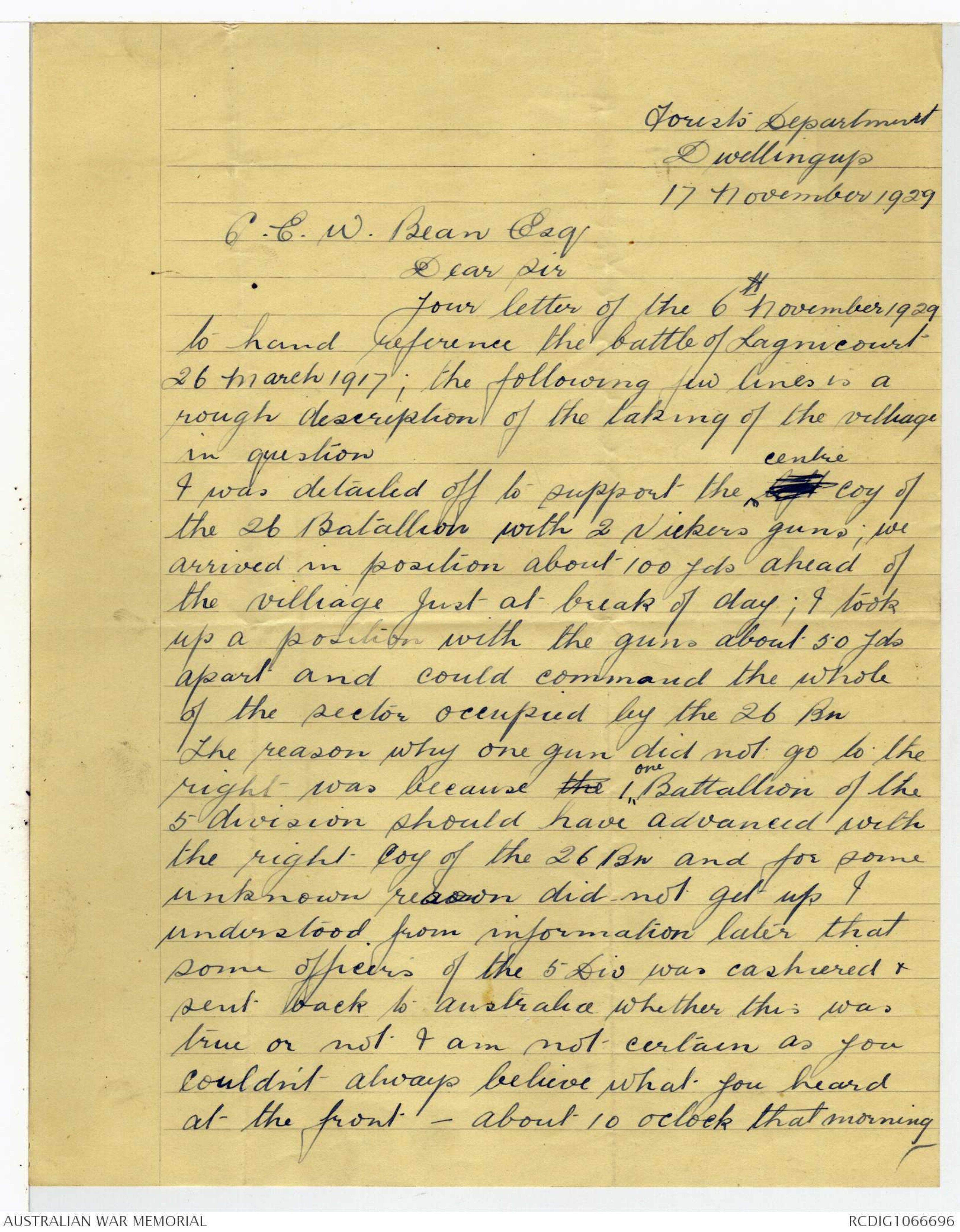
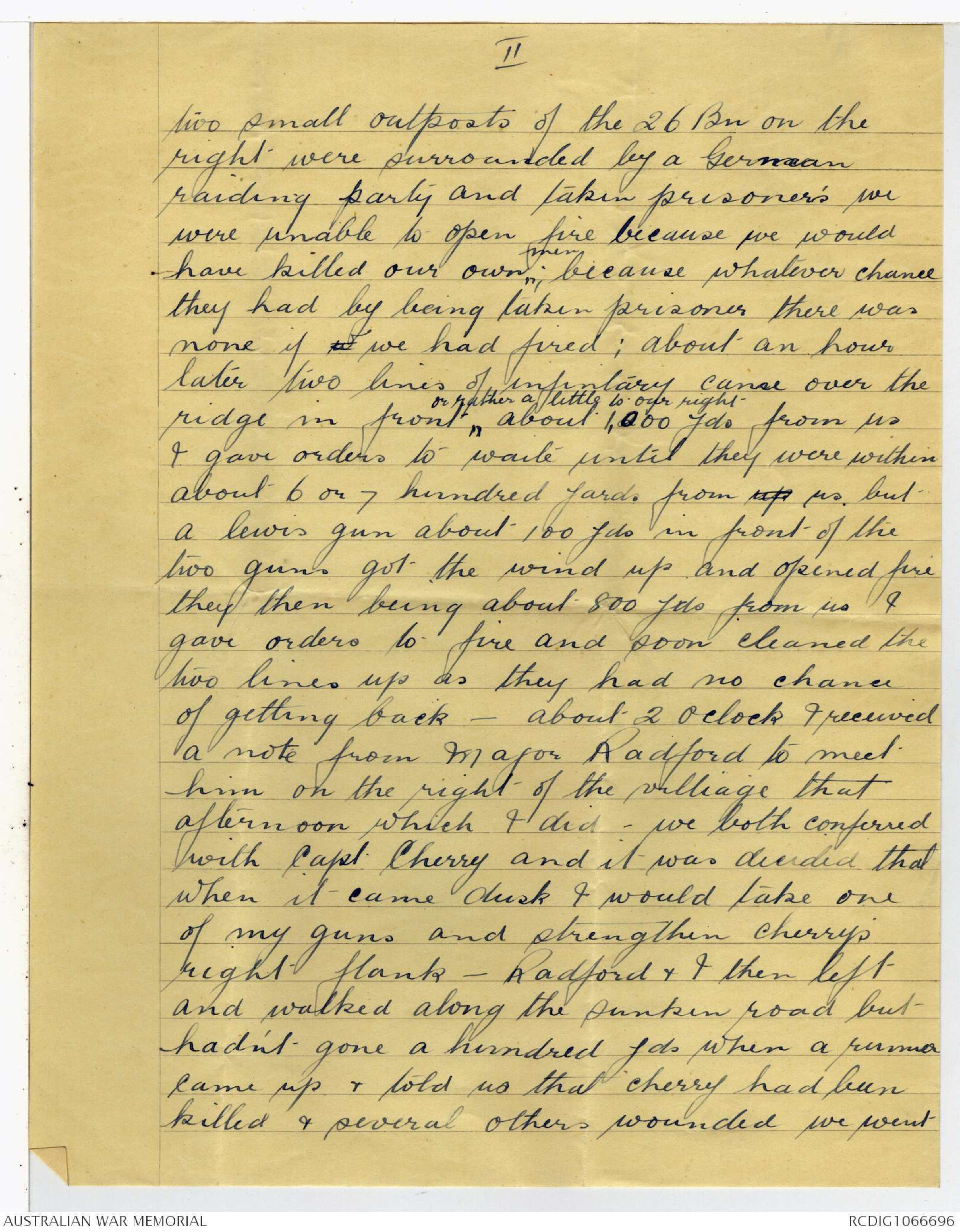
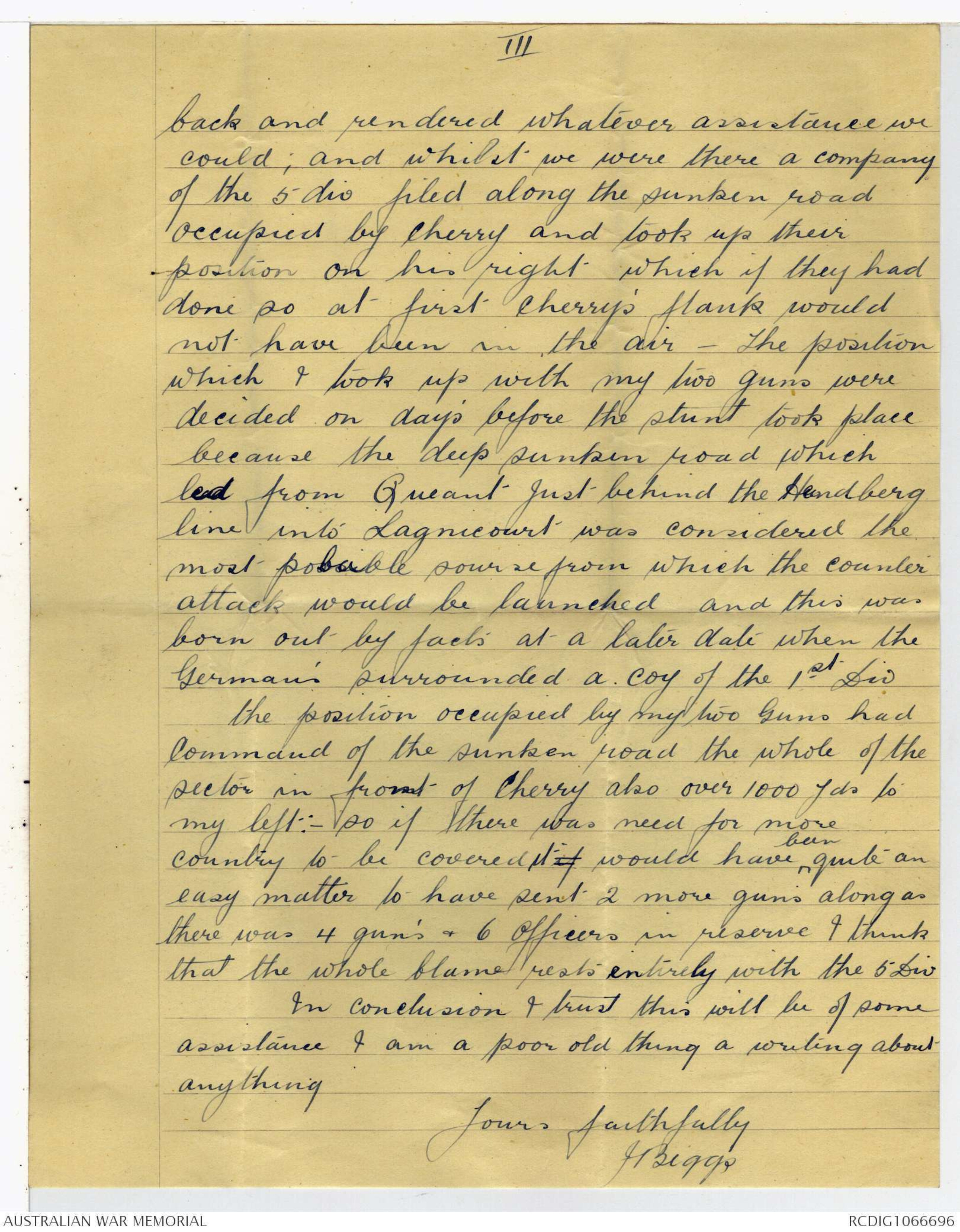
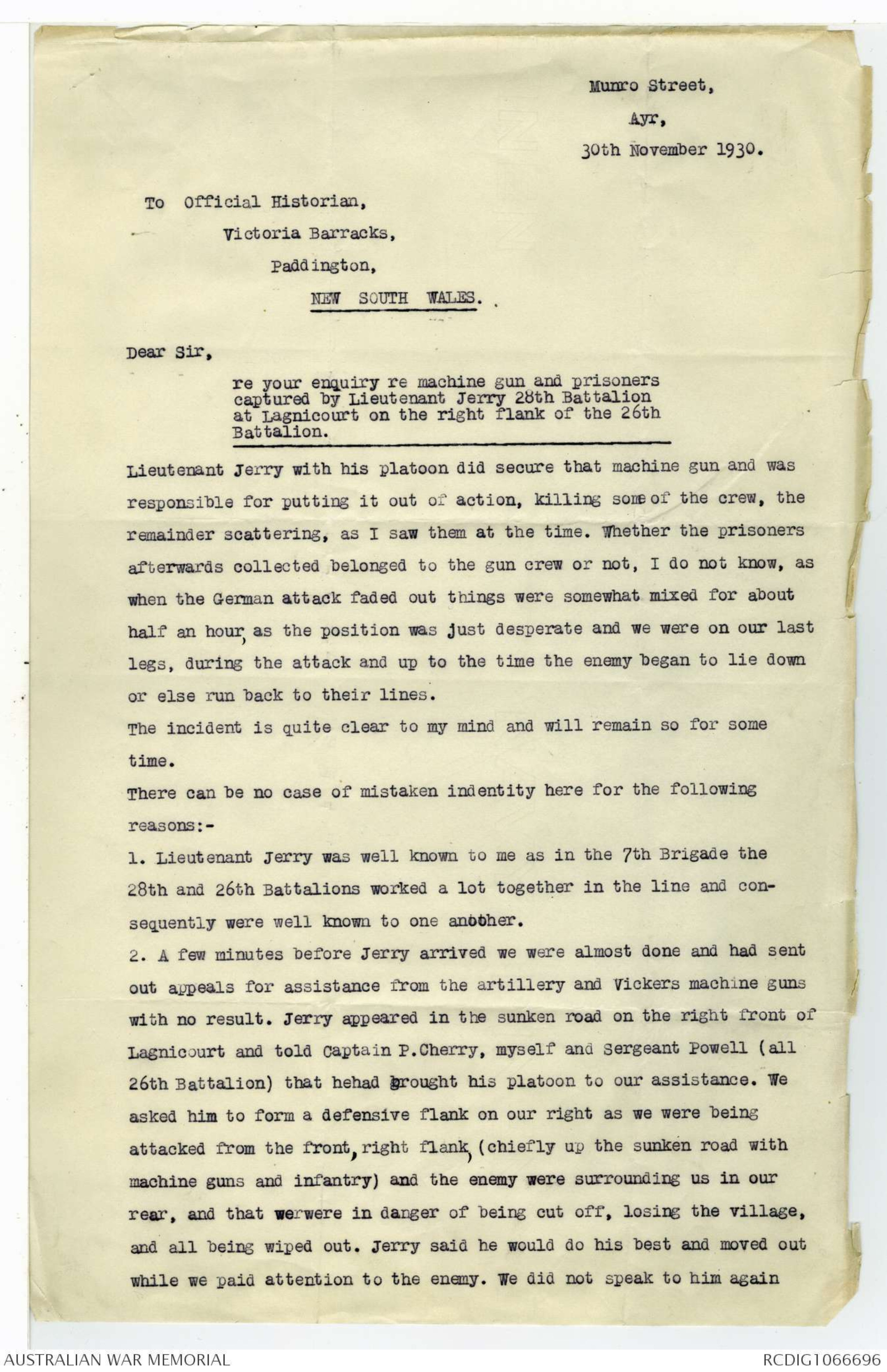
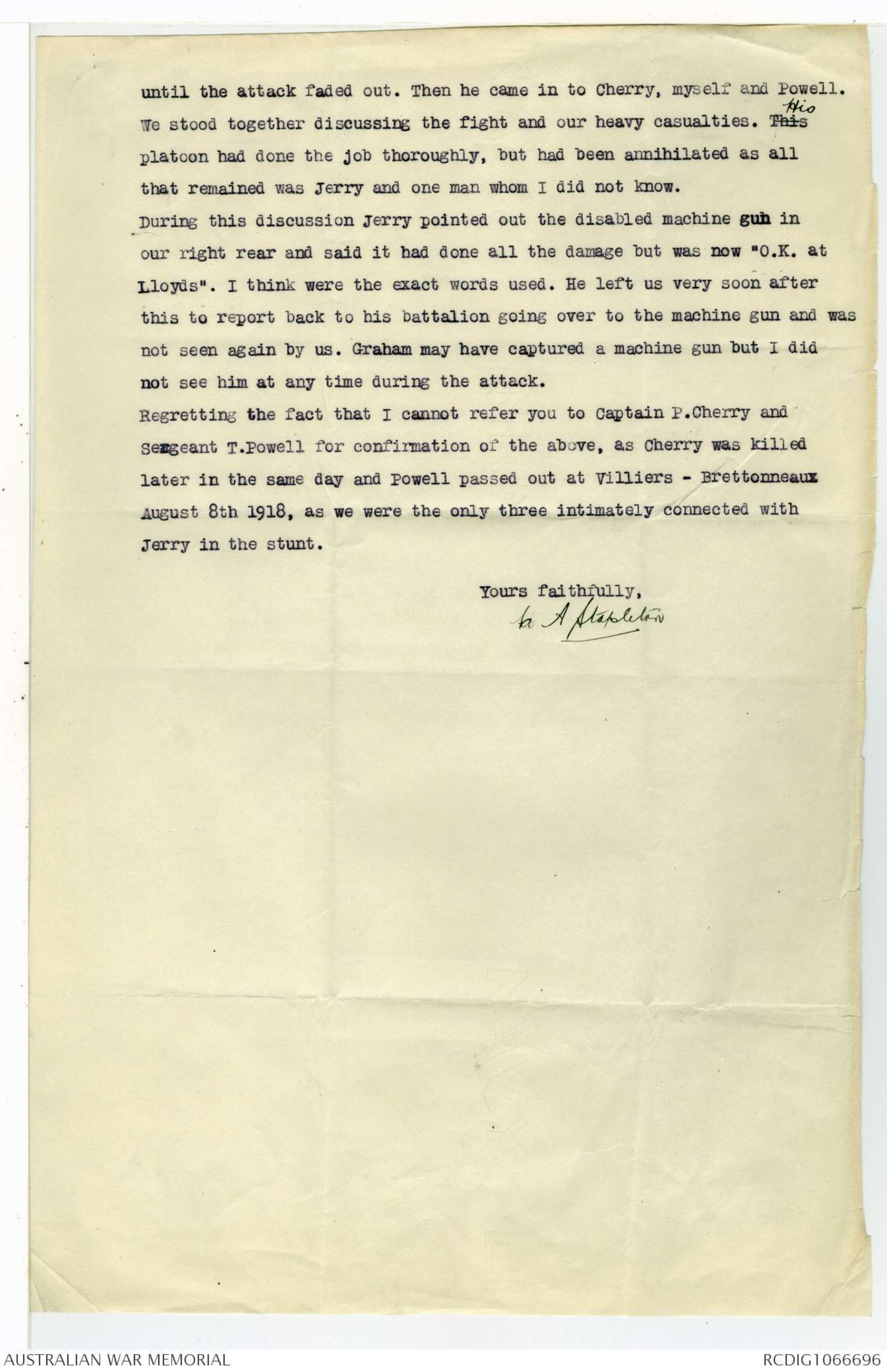
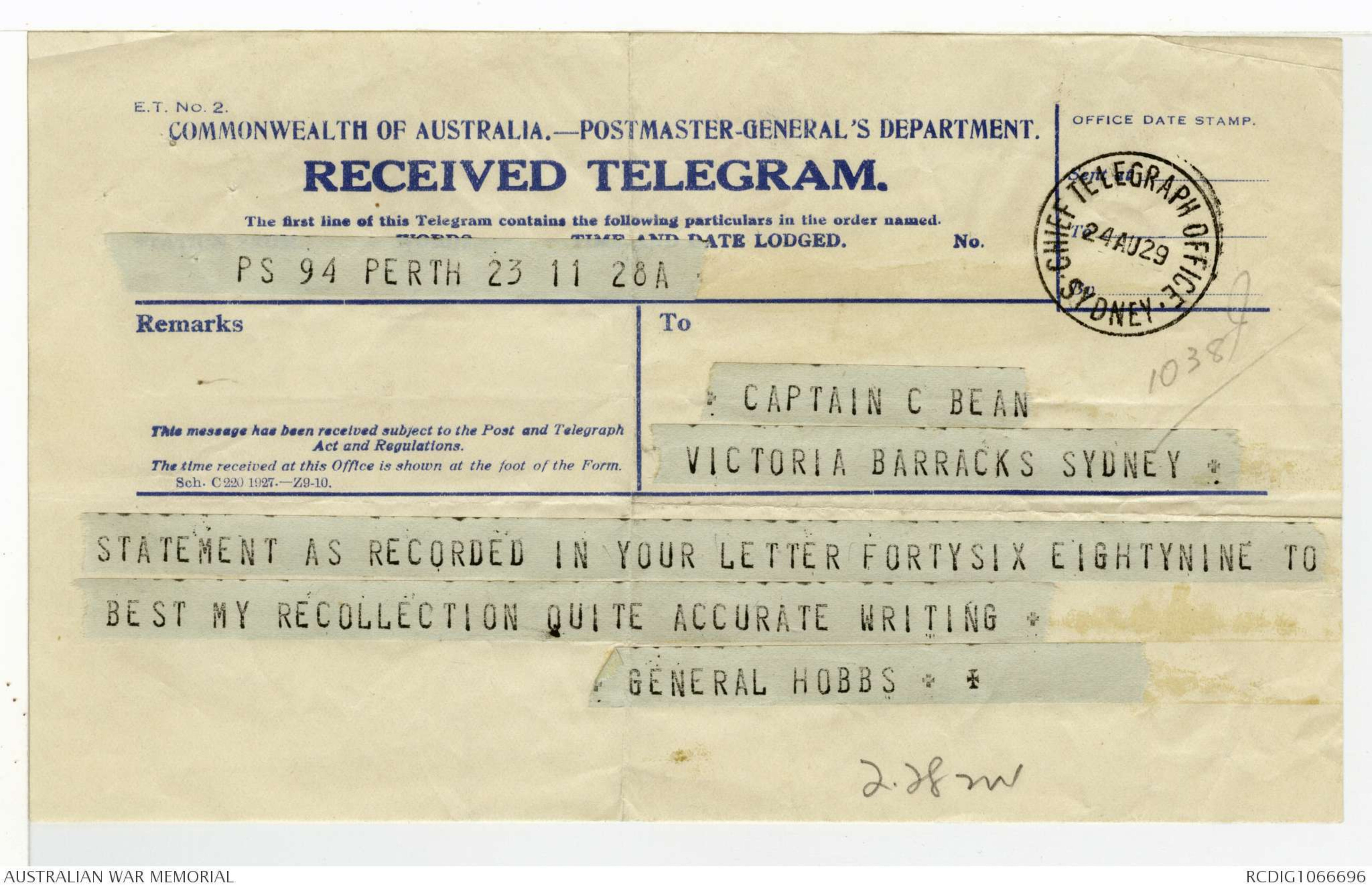
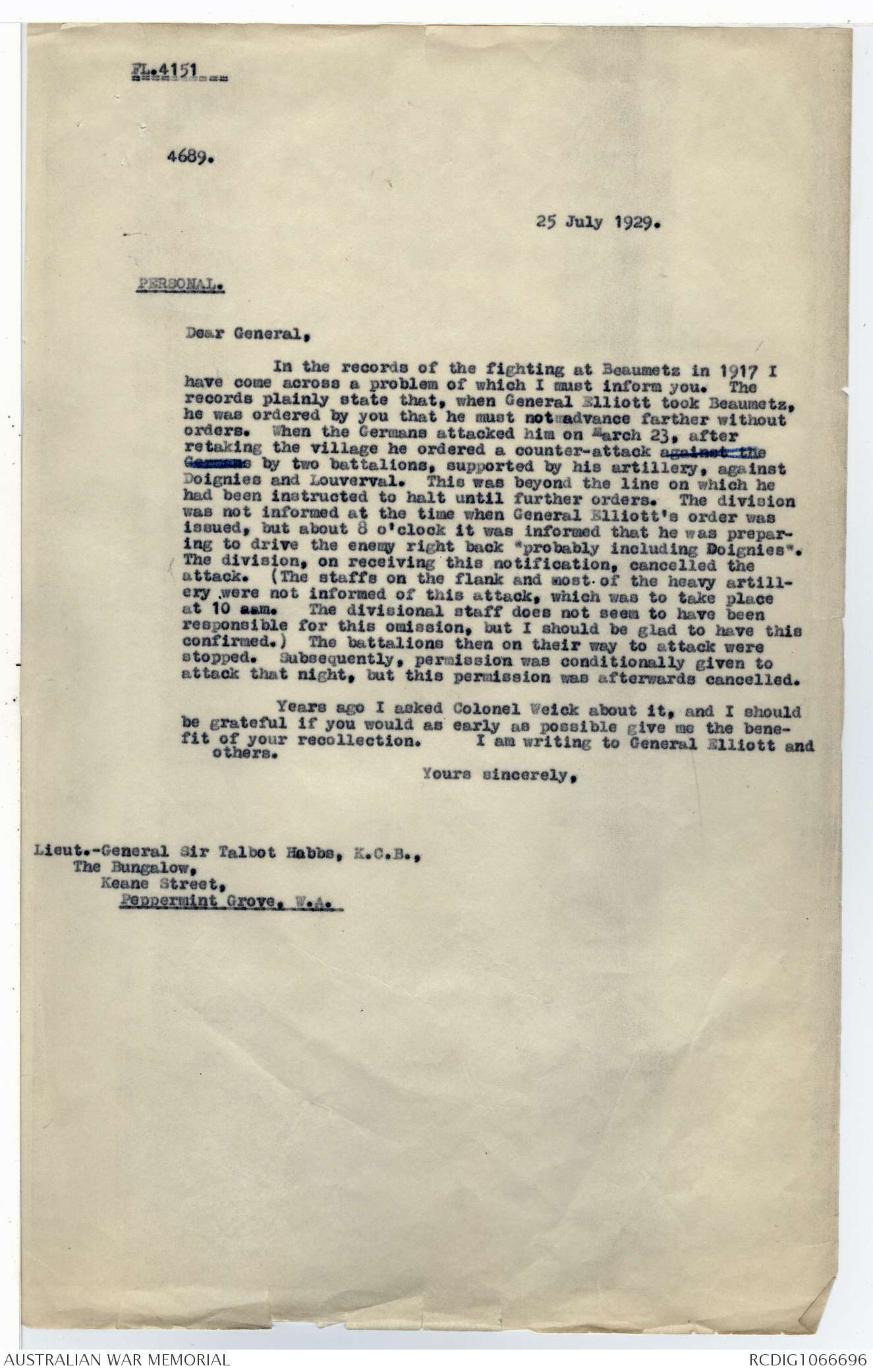
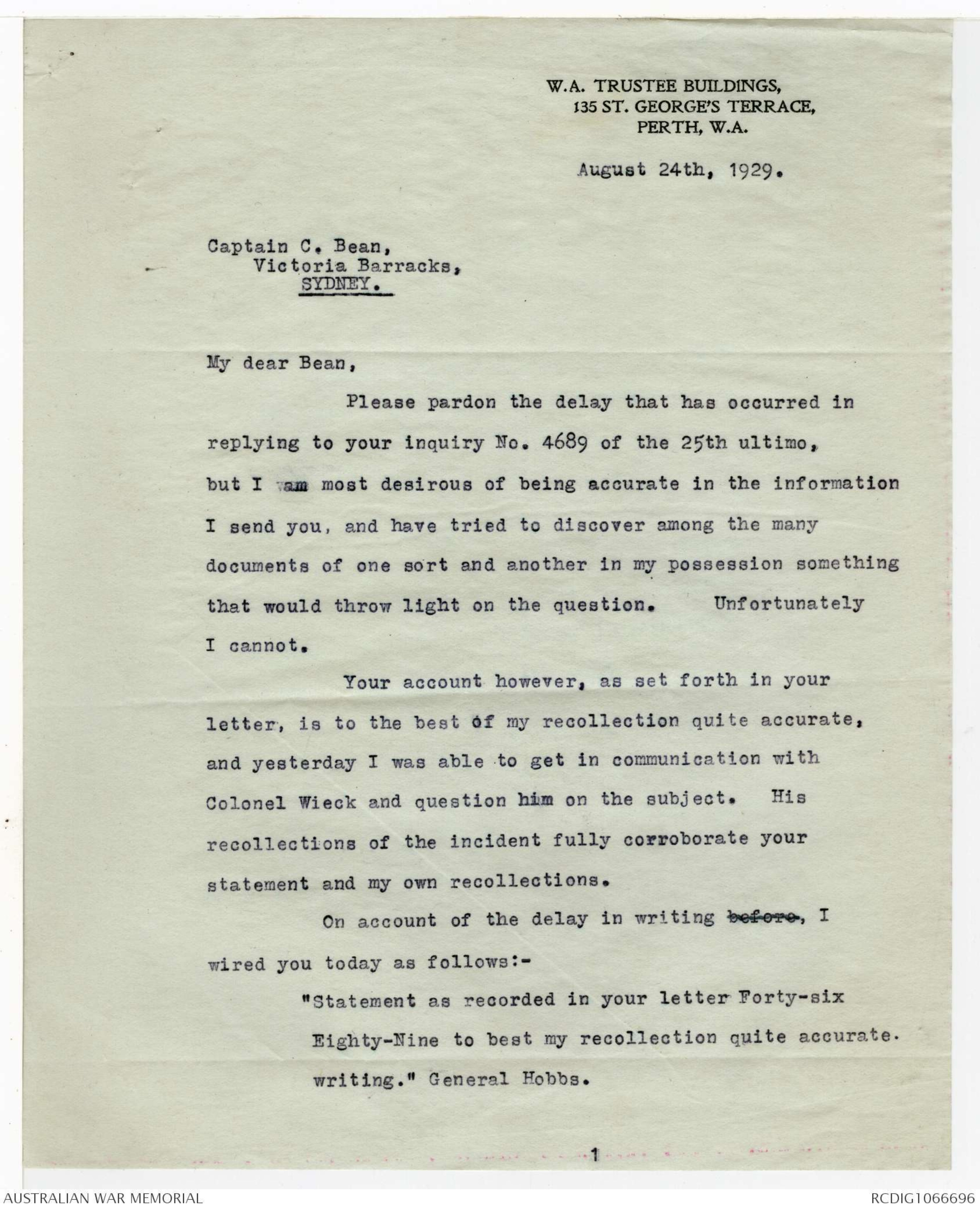
4859.
9 September 1929.
N. Graham, Esq., M.C.
71, James Street,
Guildford. W.Aust.
Dear Sir,
In writing of the Battle of Lagnicourt, I find that
the records are contradictory in respect of an incident which
occurred after the enemy's counterattack. In one account it
is stated that Lieutenant Jerry of the 28th Battalion, who was
killed later that day, took out a party of eight men to secure
a number of Germans who, with a machine-gun, had been left in
dead ground south of the village after the counter-attack had
been driven off. This account states that Jerry returned with
only one of his men surviving, but secured the gun and eight
prisoners. Another account states that, after the action, you
secured eight prisoners.
From the two accounts it seems evident that the same
party of Germans is referred to. I should be grateful if you
could note down any recollections concerning this and the other
events of that day which would assist in making the account in
the history accurate.
Yours faithfully,
5110.
5 November 1929.
J. Beggs, Esq.
Forests Department,
Dwellingup. W.Aust.
Dear Sir,
In writing the history of the battle of Lagnicourt
(26 March 19171, 1 note the work done by your two guns north
of the village. The diary of the 26th Battalion states that
one gun should have gone to the south of the village with the
right company of the 26th. I should be grateful if you could
tell me how it was that both guns went to the left. I may
mention that their effect in repelling the counterattack is
admitted in a German regimental history. On the other hand
it is possible that, if one gun had been south of the village,
the counter-attack in that quarter night have proved less
dangerous than it was. For any information on the point,
however short, I should feel greatly obliged.
Yours faithfully,
(EWBean
[[?]]
Forests Department
Dwellingup
17 November 1929
C.E.W. Bean Esq.
Dear Sir
Your letter of the 6th November 1929
to hand reference the battle of Lagnicourt
26 March 1917; the following few lines is a
rough description of the taking of the villiage
in question
I was detailed off to support the ^centre left coy of
the 26 Batallion with 2 Vickers guns; we
arrived in position about 100 yds ahead of
the village just at break of day; I took
up a position with the guns about 50 yds
apart and could command the whole
of the sector occupied by the 26 Bn
The reason why one gun did not go to the
right was because the 1^one Battallion of the
5 division should have advanced with
the right Coy of the 26 Bn and for some
unknown reason did not get up I
understood from information later that
some officers of the 5 Div was cashiered &
sent back to Australia whether this was
true or not I am not certain as you
couldn't always believe what you heard
at the front - about 10 oclock that morning
II
two small outposts of the 26 Bn on the
right were surrounded by a Germaan
raiding party and taken prisoner's we
were unable to open fire because we would
have killed our own^men, because whatever chance
they had by being taken prisoner there was
none if w we had fired; about an hour
later two lines of, infintary came over the
ridge in front ^or rather a little to our right about 1,000 yds from us
I gave orders to waite until they were within
about 6 or 7 hundred yards from up us, but
a lewis gun about 100 yds in front of the
two guns got the wind up and opened fire
they then being about 800 yds from us. I
gave orders to fire and soon cleaned the
two lines up as they had no chance
of getting back - about 2 Oclock I received
a note from Major Radford to meet
him on the right of the villiage that
afternoon which I did - we both conferred
with Capt Cherry and it was decided that
when it came dusk I would take one
of my guns and strengthen Cherry’s
right flank - Radford & I then left
and walked along the sunken road but
hadn't gone a hundred yds when a runner
came up & told us that Cherry had been
killed & several others wounded we went
III
back and rendered whatever assistance we
could; and whilst we were there a company
of the 5 div filed along the sunken road
occupied by Cherry and took up their
position on his right which if they had
done so at first Cherrys' flank would
not have been in the air - The position
which I took up with my two guns were
decided on day’s before the stunt took place
because the deep sunken road which
led from Queant just behind the Heindberg
line into Lagnicourt was considered the
most pobable sourse from which the counter
attack would be launched and this was
born out by facts at a later date when the
Germans surrounded a coy of the 1st Div
the position occupied by my two Guns had
command of the sunken road the whole of the
sector in front of Cherry also over 1000 yds to
my left:- so if there was need for more
country to be covered it if would have ^been quite an
easy matter to have sent 2 more guns along as
there was 4 gun's & 6 Officers in reserve I think
that the whole blame rests entirely with the 5 Div
In conclusion I trust this will be of some
assistance I am a poor old thing a writing about
anything
Yours faithfully
J Biggs
Munro Street,
Ayr,
30th November 1930.
To Official Historian,
Victoria Barracks,
Paddington,
NEW SOUTH WALES
Dear Sir,
re your enquiry re machine gun and prisoners
captured by Lieutenant Jerry 28th Battalion
at Lagnicourt on the right flank of the 26th
Battalion.
Lieutenant Jerry with his platoon did secure that machine gun and was
responsible for putting it out of action, Killing some of the crew, the
remainder scattering, as I saw them at the time. Whether the prisoners
afterwards collected belonged to the gun crew or not, I do not know, as
when the German attack faded out things were somewhat mixed for about
half an hour, as the position was just desperate and we were on our last
legs, during the attack and up to the time the enemy began to lie down
or else run back to their lines.
The incident is quite clear to my mind and will remain so for some
time.
There can be no case of mistaken indentity here for the following
reasons:-
1. Lieutenant Jerry was well known to me as in the 7th Brigade the
28th and 26th Battalions worked a lot together in the line and consequently were well known to one another.
2. A few minutes before Jerry arrived we were almost done and had sent
out appeals for assistance from the artillery and Vickers machine guns
with no result. Jerry appeared in the sunken road on the right front of
Lagnicourt and told Captain P.Cherry, myself and Sergeant Powell (all
26th Battalion) that hehad brought his platoon to our assistance. We
asked him to form a defensive flank on our right as we were being
attacked from the front, right flank (chiefly up the sunken road with
machine guns and infantry) and the enemy were surrounding us in our
rear, and that werwere in danger of being cut off, losing the village
and all being wiped out. Jerry said he would do his best and moved out
while we paid attention to the enemy. We did not speak to him again
until the attack faded out. Then he came in to Cherry, myself and Powell.
We stood together discussing the fight and our heavy casualties. This His
platoon had done the job thoroughly, but had been annihilated as all
that remained was Jerry and one man whom I did not know.
During this discussion Jerry pointed out the disabled machine gun in
our right rear and said it had done all the damage but was now "O.K. at
Lloyds". I think were the exact words used. He left us very soon after
this to report back to his battalion going over to the machine gun and was
not seen again by us. Graham may have captured a machine gun but I did
not see him at any time during the attack.
Regretting the fact that I cannot refer you to Captain P.Cherry and
Sergeant T.Powell for confirmation of the above, as Cherry was killed
later in the same day and Powell passed out at Villiers - Brettonneaux
August 8th 1918, as we were the only three intimately connected with
Jerry in the stunt.
Yours faithfully,
C A Stapleton
E.T. No. 2.
OFFICE DATE STAMP
CHIEF TELEGRAPH OFFICE SYDNEY
24AU29
COMMONWEALTH OF AUSTRALIA.-POSTMASTER-GENERALS DEPARTMENT.
RECEIVED TELEGRAM.
The first line of this Telegram contains the following particulars in the order named.
WORDS TIME AND DATE LODGED
PS 94 PERTH 23 11 28A
Remarks
This message has been received subject to the Post and Telegraph
Act and Regulations
The time received at this Office is shown at the foot of the Form.
To
CAPTAIN C BEAN 1038J
VICTORIA BARRACKS SYDNEY
STATEMENT AS RECORDED IN YOUR LETTER FORTYSIX EIGHTYNINE TO
BEST MY RECOLLECTION QUITE ACCURATE WRITING +
GENERAL HOBBS +
J.H.W
FL.4151
4689.
25 July 1929.
PERSONAL.
Dear General,
In the records of the fighting at Beaumetz in 1917 I
have come across a problem of which I must inform you. The
records plainly state that, when General Elliott took Beaumetz,
he was ordered by you that he must not andvance farther without
orders. When the Germans attacked him on March 23, after
retaking the village he ordered a counter-attack against theGermans by two battalions, supported by his artillery, against
Doignies and Louverval. This was beyond the line on which he
had been instructed to halt until further orders. The division
was not informed at the time when General Elliott’s order was
issued, but about 8 o'clock it was informed that he was preparing to drive the enemy right back "probably including Doignies".
The division, on receiving this notification, cancelled the
attack. (The staffs on the flank and most. of the heavy artillery were not informed of this attack, which was to take place
at 10 a.m. The divisional staff does not seem to have been
responsible for this omission, but I should be glad to have this
confirmed.) The battalions then on their way to attack were
stopped. Subsequently, permission was conditionally given to
attack that night, but this permission was afterwards cancelled.
Years ago I asked Colonel Weick about it, and I should
be grateful if you would as early as possible give me the benefit of your recollection. I am writing to General Elliott and
others.
Yours sincerely,
Lieut.-General Sir Talbot Hobbs, K.C.B.,
The Bungalow,
Keane Street,
Peppermint Grove, W.A.
W.A. TRUSTEE BUILDINGS,
135 ST. GEORGES TERRACE,
PERTH, W.A.
August 24th, 1929.
Captain C. Bean
Victoria Barracks,
SYDNEY.
My dear Bean,
Please pardon the delay that has occurred in
replying to your inquiry No. 4689 of the 25th ultimo,
but I am most desirous of being accurate in the information
I send you, and have tried to discover among the many
documents of one sort and another in my possession something
that would throw light on the question. Unfortunately
I cannot.
Your account however, as set forth in your
letter, is to the best of my recollection quite accurate,
and yesterday I was able to get in communication with
Colonel Wieck and question him on the subject. His
recollections of the incident fully corroborate your
statement and my own recollections.
On account of the delay in writing before, I
wired you today as follows:-
Statement as recorded in your letter Forty-six
Eighty-Nine to best my recollection quite accurate.
writing. General Hobbs.
This transcription item is now locked to you for editing. To release the lock either Save your changes or Cancel.
This lock will be automatically released after 60 minutes of inactivity.